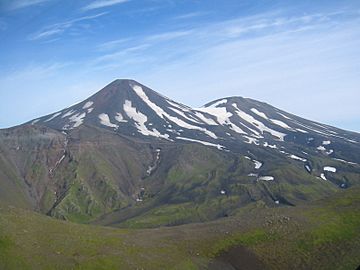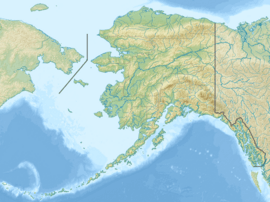Tanaga (volcano) facts for kids
Quick facts for kids Tanaga |
|
|---|---|

Tanaga
|
|
| Highest point | |
| Elevation | 5,925 ft (1,806 m) |
| Prominence | 5,925 ft (1,806 m) |
| Listing |
|
| Geography | |
| Location | Tanaga Island, Alaska, U.S. |
| Parent range | Aleutian Range |
| Geology | |
| Mountain type | Stratovolcano |
| Volcanic arc/belt | Aleutian Arc |
| Last eruption | 1914 |
Tanaga (which means Kusuuginax̂ in the Aleut language) is a tall stratovolcano located in Alaska, a state in the United States. It stands 5,924 feet (1,806 meters) high. Tanaga is part of the Aleutian Range, a chain of mountains and volcanoes.
This volcano has erupted a few times in recorded history. The most recent eruption happened in 1914. It created lava flows, which are streams of hot, melted rock. Tanaga is also near another volcano called Mount Takawangha.
About Tanaga Volcano
Tanaga is a type of volcano called a stratovolcano. These volcanoes are also known as composite volcanoes. They are usually tall and cone-shaped. Stratovolcanoes are built up over time by many layers of hardened lava, tephra (ash, pumice, and other rock fragments), and volcanic ash.
Where is Tanaga?
Tanaga volcano is found on Tanaga Island. This island is part of the Aleutian Islands, which stretch out from the main part of Alaska. The Aleutian Islands are known for having many volcanoes. They are part of the Aleutian Arc, a long chain of volcanoes formed by tectonic plates moving.
Eruptions of Tanaga
Scientists know of three eruptions from Tanaga volcano since the year 1763.
- The first known eruption happened sometime after 1763.
- Another eruption took place in 1829.
- The most recent eruption was in 1914. This event produced lava flows.
Volcanoes like Tanaga are constantly monitored. This helps scientists understand their activity. It also helps keep people safe who live near them.


